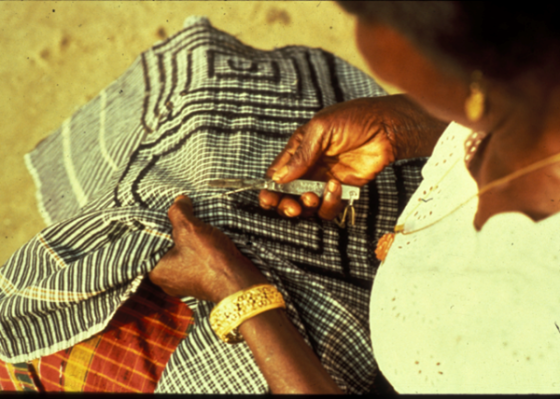The island group occupied by the Kalabari people is located in the Niger River delta. This strategic position brought them into contact with traders and travelers from many African and non-African cultures over a period of centuries. Their dress traditions are marked by an eclectic and cosmopolitan combination of cultural references. [1]
Kalabari cut-thread cloth takes imported Indian cotton madras as a starting point, but the subtractive process by which it becomes pelete bite is a transformative one. Beginning with fine Indian cotton with stripes, plaids or small checks, the embroiderers selectively remove threads from the fabric by picking them up with a needle, cutting them with a razor blade, and pulling them from the weave. Often the lightest and brightest threads are removed, leaving a striking dark geometric design on a lighter checked ground. [2]
Pelete bite are worn as wrappers, singly by men or in an “up and down” combination of a knee-length wrapper over an ankle-length one by women, with an imported lace blouse. Kalabari women aspire to the quality of iria-bo ti, or feminine elegance, characterized by refinement in speech, manners and dress. [3] The dark colors and controlled patterns of pelete bite are an enduring expression of feminine elegance.
[1] M. Catherine Daly, Joanne B. Eicher, and Tonye V. Erekosima, “Male and Female Artistry in Kalabari Dress,” African Arts 19, no. 3 (May 1986): 48.
[2] Joanne B. Eicher, “A Ping-Pong Example of Cultural Authentication and Kalabari Cut-Thread Cloth” in Appropriation, Acculturation, Transformation: Proceedings of the Textile Society of America 9th Biennial Symposium, Oakland, October 7–9, 2004: paper 439.
[3] Tonye Victor Erekosima and Joanne B. Eicher, “Kalabari Cut-thread and Pulled-thread Cloth,” African Arts vol. 14 no. 2 (Feb. 1981), p. 49.
This wrapper is on view in the exhibition David Adjaye Selects: Works from the Permanent Collection, along with thirteen other pieces from the museum’s African textile collection.
Susan Brown is Associate Curator in the Textiles Department at Cooper Hewitt, Smithsonian Design Museum.


